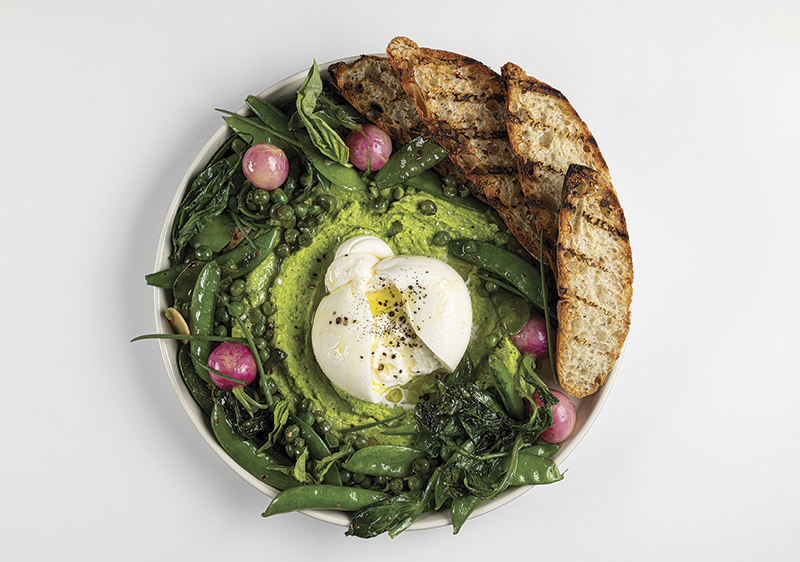
Brilliant green English peas are one of the little joys of spring. Although I deplored them as a child (having really only experienced the canned version), I now can’t imagine a spring without them. In the garden, I love the idea of peas, but our erratic spring weather can make them a bit of a challenge in the Midwest. English peas really need an extended period of cool weather to thrive, but I have had great success with sugar snap and snow peas here. And while those varieties don’t have quite the same complex “pea” flavor, their texture and sweetness satisfies my spring pea cravings.
My fascination with peas began in my early 20s when I was reading everything about cooking that I could get my hands on (some things haven’t changed). It was in An Alphabet for Gourmets by M.F.K Fisher, the chapter “P is for Peas,” discussing her transcendent moments with the tiny legume. What had I been missing? My curiosity piqued, I have been on a decades long search for exactly such moments. The following recipe is my celebration of three types of spring peas. And although it may not provide the ecstasy of Mrs. Fisher’s freshly picked peas cooked in the open air on a hillside in the south of France, I do think you will enjoy it.
Spring Peas and Burrata
This dish is a celebration of peas in all their variety (see In Your Pantry below), and it is perfect for sharing at all manner of spring celebrations. It begins with a bed of pea purée, followed by a fresh sauté of more peas, edible pod peas, radishes, and herbs, and is topped with burrata, the cheese that is currently almost inescapable—with good reason—in culinary circles. The recipe is easily doubled or even tripled.
Begin with the pea purée: In a saucepan, add 2 tablespoons of extra-virgin olive oil or butter. Slice a clove of garlic and/or a shallot (or spring onion), add them to the pan and sauté until translucent, about 4 minutes. Pour in a cup of water or mild stock, one pound of frozen peas (if they look frosty in the bag, you should rinse them under running water before adding), and season with a dash of salt and pepper. Bring the peas to a boil and simmer for 2-3 minutes (if you are blessed with an overabundance of fresh peas and wanted to use them in this recipe, they would need an extra minute or two—taste to test for tenderness). Take the pan from the heat, and drain off about half of the water, reserving the liquid to adjust the thickness of the purée. Stir in a few leaves of mint or basil, and add another 2 tablespoons of olive oil or butter. With an immersion blender or food processor, purée the peas, adding back the reserved liquid as needed to reach your desired density and texture, tasting for seasoning as well. The purée can be served, warm, at room temperature, or even cool.
Continue with the vegetable garnish: Prepare the vegetables as follows, keeping in mind that omissions or additions can be made based on what variety you have available. Wash a handful of small radishes, leaving the greens attached if they are pristine, and cut a small X about ¼ inch deep into the bottom of each (that helps decrease the cooking time). Wash a big handful each of sugar snap peas and snow peas, checking for tough strings on the sides of the peas (this is most likely to happen on snow peas, especially when they are larger). Wash a handful of pea tendrils, cutting them into shorter lengths if they are large. Cut a green onion or chives into shorter lengths. Have ready a cup of fresh (preferably) or frozen English peas. When all the vegetables are prepared, heat a large skillet. Pour in a few tablespoons of olive oil, and briefly sauté a sliced clove of garlic, the radishes and the fresh peas if using—frozen peas should wait until closer to the end of cooking time. Season with salt and a pinch of crushed red pepper flakes. Toss, then, adding a few tablespoons of water to prevent scorching, cover the skillet and allow the radishes and peas to cook for 2-3 minutes. Uncover, toss again, and drop in the sugar snap peas, frozen peas, and pea tendrils. Toss again, taste to check seasoning, and set the pan aside to cool.
Assemble the dish: On a large plate, spread the pea purée, leaving a little room around the edge. With a large spoon or tongs, surround the purée with a ring of the cooked vegetables, and scatter the chives or scallions about—if you have any more mint or basil leaves, those would be lovely here as well. Place a ball of fresh burrata cheese in the center of the plate, and cut it down the center to allow access to the creamy shreds inside. Drizzle the cheese and vegetables with your best extra-virgin olive oil, and season the cheese with a few grinds of fresh black pepper and sea salt. If you don’t have burrata, any number of fresh young cheeses, like a Tuscan Pecorino or tangy goat cheese, could stand in its place—Boursin, creme fraiche, labne, or even a dollop of yogurt or sour cream would also work, or you could omit the cheese entirely. Serve the dish with slices of grilled country bread or ciabatta, preferably somewhere with a stunning view, beautiful weather, and loved ones in abundance.
In Your Pantry: So Many Peas!

Frozen vs Fresh. There is absolutely nothing wrong with frozen peas. They are a work horse ingredient in many professional kitchens. Unless you have access to extremely fresh and not overly mature peas, say picked straight from the garden or farmers market (and even from the market, you don’t know exactly how long they’ve been picked), the fresh kind can be almost unpleasantly starchy and without a hint of the sweetness and the bright “green” flavor that makes them such a pleasure to eat. When they are young and fresh, English peas are remarkably tender and sweet, needing only the briefest of cooking in a little butter with salt and pepper—nothing else. Fresh peas do have the ability to stand up to longer cooking periods, and in cases where they are a little more mature, they require a longer cooking time to make them tender and less starchy. If you shell your own peas or have the good luck to find them already shelled at the market, a close examination will help tell you their age—if the pods are older, you will see some of the individual peas beginning to sprout little white tails.

Sugar Snap and Snow Peas. As their French name (Mange tout or mangetout) explains, with these peas you can “eat it all.” Sugar snap peas, with their fat crunchy pods with peas forming inside, look much like ordinary English peas, but the succulent pods are entirely and deliciously edible. Snow peas, with their thin, flat longer pods, are equally sweet with a refreshing vegetal flavor and require only the briefest of cooking times—just a minute or two at the most. Both kinds are a treat, raw and straight from the vine, for gardeners needing a little snack while working. When preparing either type of edible pod pea, always check a few to make sure they haven’t formed tough strings running down the seams on either edge of the pod. Modern varieties have—for the most part—had this trait bred out, but occasionally you still find strings. The string is easily removed by pulling it from one end to the other like pulling a zipper.

Pigeon Peas. Unlike English peas, this pulse (the edible seed of a legume) thrives in hot climates where they are extremely popular and form a basic element of many tropical cuisines. Like most legumes, when paired with rice they form a nutritionally complete protein. They are extremely versatile and are especially favored in Caribbean and Indian cuisines. Look for them in dried, fresh, or frozen form in larger grocery stores.

Dried Split Peas. Often misunderstood, dried split peas (exactly what their name suggests) should be a staple in every pantry. They are quick cooking and dissolve rapidly into a savory purée whose consistency can be easily adjusted simply by adding water, stock, butter, or oil. Split peas are frequently paired with a little ham or bacon, onions, carrots, and celery to make a comforting meal, perfect for a cool spring evening. A few tablespoons added to a watery soup, followed by 20 minutes of cooking can lend a satisfying velvety texture. Split peas are very companionable to many herbs and take well to countless seasonings.

Pea Tendrils. Long popular in Europe and Asia, pea tips and tendrils—the tender, growing end of the pea vine—are rapidly growing in popularity in the Midwest. They generally come in two sizes (large and small pea tips), the larger variety often benefitting from being cut into smaller sections (as they grow larger they can develop more fiber and become tough). When small, they are delicious tossed directly into a salad and dressed like lettuce. Larger tendrils are best given a brief sauté with a few slices of garlic, the way you might quickly cook spinach. Look for them in the produce section, especially at Asian grocers.

